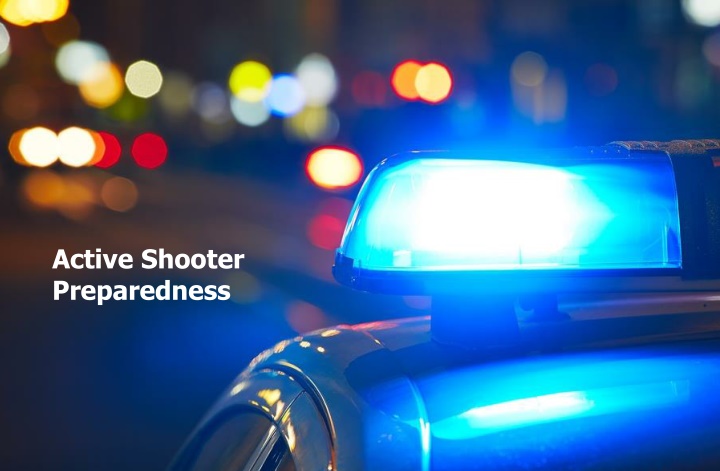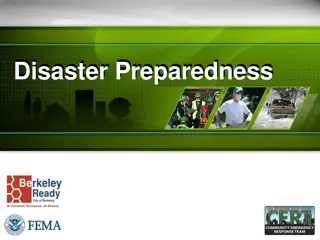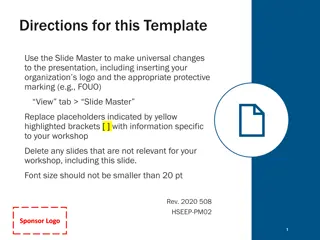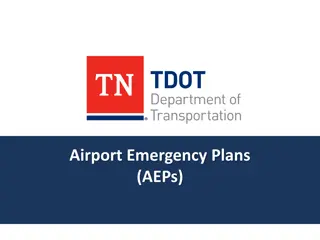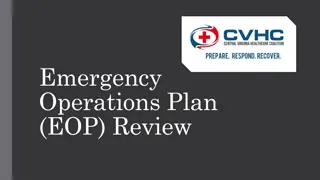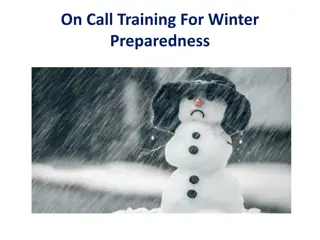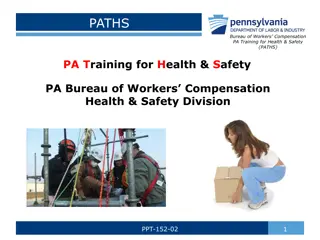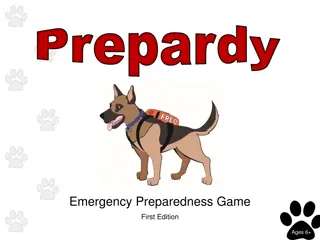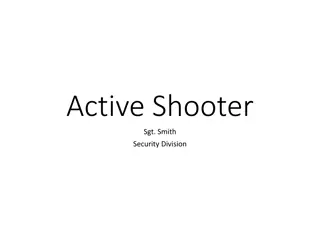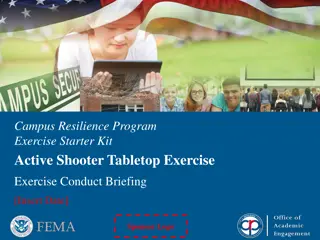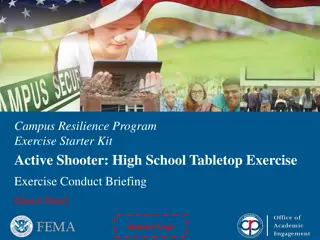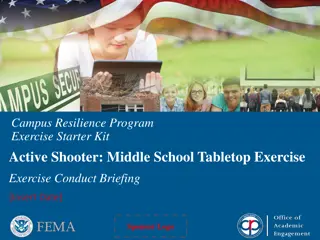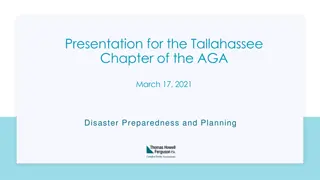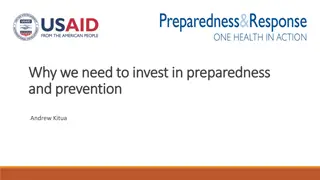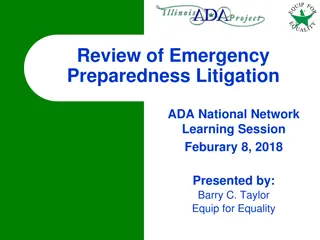Active Shooter Preparedness Training Overview
This presentation provides essential information on active shooter preparedness, including organizational readiness, response strategies, and post-incident actions. It emphasizes the importance of having an emergency action plan, conducting training exercises, recognizing warning signs of workplace violence, and engaging in preventive measures. The content also underscores the need for collaboration with internal and external resources to enhance preparedness and ensure proper procedures during active shooter situations.
Download Presentation

Please find below an Image/Link to download the presentation.
The content on the website is provided AS IS for your information and personal use only. It may not be sold, licensed, or shared on other websites without obtaining consent from the author.If you encounter any issues during the download, it is possible that the publisher has removed the file from their server.
You are allowed to download the files provided on this website for personal or commercial use, subject to the condition that they are used lawfully. All files are the property of their respective owners.
The content on the website is provided AS IS for your information and personal use only. It may not be sold, licensed, or shared on other websites without obtaining consent from the author.
E N D
Presentation Transcript
Active Shooter Preparedness
Introduction How to Use this Presentation DISCLAIMER This training material presents very important, pertinent information. It should not be assumed, however, that this program satisfies every legal requirement of every state. Some states require the training be developed and delivered by an individual with specific training and experience. This presentation contains base material for use in an instructor-led training setting. You may modify this presentation to satisfy the specific training needs of your organization. This training is AWARENESS LEVEL and does not authorize any person to perform work or validate their level of competency; it must be supplemented with operation and process- specific assessments and training, as well as management oversight, to assure that all training is understood and followed. On some slides, the display text is supplemented with additional material in the slide notes. This content is licensed for modification and use in a classroom setting. You may not redistribute this material in any form. Your organization must do an evaluation of all exposures and applicable codes and regulations. In addition, establish proper controls, training, and protective measures to effectively control exposures and assure compliance. This program is neither a determination that the conditions and practices of your organization are safe, nor a warranty that reliance upon this program will prevent accidents and losses or satisfy local, state, or federal regulations.
Introduction An active shooter is an individual actively engaged in killing or attempting to kill in a confined or populated area. Statistics: On average, active shooter incidents occur every three weeks. The majority of these incidents end before law enforcement can arrive.
Course Outline 1. Organizational Preparedness 2. Active Shooter Response 3. Post-Incident Actions
Organizational Preparedness Part 1 What you need to know: 1. Emergency action plan 2. Training exercises 3. Other preventive measures and responsibilities 4. Warning signs of workplace violence
Emergency Action Plan Organizational Preparedness The benefits: A successful plan should include the following: Preparing an emergency action plan helps all employees to know and understand proper procedures for dealing with an active shooter situation and its aftermath. How to report emergencies to the proper authorities, services, and individuals stationed at remote locations within the premises Evacuation policies and escape procedures, including multiple clearly posted routes and safe areas Resources: When creating the plan, consult with internal departments such as Human Resources (HR) and training departments, as well as external resources such as facility owners and operators, property management, local law enforcement, and emergency response services. Contact information for area hospitals and individuals who perform specific tasks during emergencies
Training Exercises Organizational Preparedness Develop training exercises that simulate active shooter situations. The benefits: Training includes the following: Recognizing the sound of gunfire Powerfully educating employees about the emergency action plan How to react to gunfire When to dial 911 Reinforcing practices that may save lives What to do when law enforcement arrives Enlisting help: Developing a survival mindset Contact local law enforcement and emergency response agencies for their assistance in designing or facilitating any trainings. Offer your facility as a site for future active shooter trainings. The next section will discuss in greater detail what should be included in employee training.
Preventative Measures Organizational Preparedness Cultivate a respectful environment in the workplace. Active Shooter Incidents by Location Watch for signs of workplace violence and take corrective actions as necessary. Education 24.4% Commerce 45.6% Government 10.0% Open Space 9.4% Health Care Facilities 2.5% House of Worship 3.8% Residences 4.4%
Preventative Measures Organizational Preparedness 39 Organizational Responsibilities: Perform screening and background checks for all new employees. incidents occurred in educational environments that resulted in 117 individuals killed and 120 injured (2010 2013). Implement a system that allows individuals to report signs or occurrences of violent behavior. Provide resources for counseling. Assist in preparing the emergency action plan.
Preventative Measures Organizational Preparedness Responsibilities for the facility manager: Prepare and distribute crisis kits that include radios, floor plans, personnel lists, flashlights, and first aid supplies. Implement access controls throughout the premises, such as electronic security systems and keys. Assure that facility security personnel is properly trained and able to maintain the premises physical security. Assure that items such as floor plans, personnel lists, contact information, and facility keys are provided for appropriate managers and employees. Post removable floor plans at all entrances and exits.
Warning Signs Organizational Preparedness Before an incident, active shooters usually exhibit traits of potentially violent behavior over an extended period of time. Know the warning signs and train employees to be aware of them. Employees should report signs of potentially violent behavior to a manager or HR. These signs may indicate issues that can be treated or managed with medication or therapy.
Warning Signs Organizational Preparedness Common traits that may be indicative of potentially violent behavior: Increased use of drugs or alcohol Increased talk of personal, financial, or domestic issues in the work place Decreased attention to personal appearance or hygiene habits Increased absences with vague or no explanation Resistance to policy or procedural changes Feelings of depression or withdrawal Increased severe mood swings Repeated disregard for organizational policy Unprovoked outbursts of anger or rage Unstable or over-emotional reactions Paranoid behavior Talk of suicide or preparing for death Talk of previous violent incidents and empathy towards individuals committing them Increased unprompted talk of firearms, other weapons, or violent crimes This list only presents common signs of violent behavior: it is neither comprehensive nor to be used as a diagnostic tool.
Shooter Statistics Organizational Preparedness Active Shooters (By Gender) Active shooters are usually associated with the location of the incident. They may be current or former employees or friends or relations of employees. Percentage of Shooters Employed by the Business Male: 96.25% 100 Female: 3.75% 50 0 Closed to Pedestrian Traffic: 95% of shooters were employees Open to Pedestrian Traffic: 27% of shooters were employees
Active Shooter Response Part 2 What you need to know: 1. What to do during an active shooter incident 2. When it is safe to call 911 3. How to react once emergency personnel arrive
What To Expect Active Shooter Response The outcome of 67 Incidents in Commerce Areas (2000 2013) Active shooter incidents are rarely prolonged. Many are over in a matter of minutes, often before law enforcement can arrive. They often end when active shooters stop shooting and flee the scene or take their own lives. 35 shooters committed suicide. 12 shooters were apprehended at the scene. 8 shooters fled and were apprehended elsewhere. 8 shooters were killed by law enforcement. 2 shooters fled and were not apprehended. 1 shooter was killed by a citizen.
Evacuation Active Shooter Response Your first plan should always be to evacuate the premises if a safe route is accessible. If the workplace is open to customer or client traffic, it is important that you know the best way to respond, as non-employees may look to you for what to do. Tips: Try to determine your route before starting to move. Try to keep others from moving towards areas where the shooter might be. Even if others decide not to follow, continue evacuation. If you encounter any police officers, follow any instructions they give. Leave behind any belongings not already on you. Keep your hands visible. Do not try to move any wounded individuals. If possible, help others to escape.
Hiding Active Shooter Response If you are unable to evacuate, find a safe place to hide. A safe hiding place should: Be out of view from the shooter. Protect you from gunfire in your direction (e.g., an office with no interior windows and a closed, locked door). Allow safe access to possible evacuation routes.
Hiding Active Shooter Response If the shooter approaches your hiding place: If possible, lock and blockade the door. Set any mobile devices (e.g., cell phones, pagers) to silent, and turn off any other sources of noise, such as computers, TVs, or radios. Find a large item to hide behind. Stay quiet.
If Unable to Evacuate or Hide Active Shooter Response Keep calm. If possible, call 911 to notify police of the shooter s location.
Calling 911 Active Shooter Response Do not call 911 unless it is safe to do so. In an active shooter incident, your own safety should be your first priority. Let the dispatcher know the following: Location of the shooter Number of shooters (if more than one) Make sure you can either evacuate the premises or find a safe hiding place before calling 911. Physical description of the shooter Number and type of weapons held by the shooter If you are unable to speak or if it is unsafe to do so, keep the line open to allow the dispatcher to listen in. Number of potential victims at the location
The Last Resort Active Shooter Response 21 Attempting to incapacitate an active shooter is strictly a last resort. Never attempt to confront a shooter unless your life is in immediate danger and there are no safe evacuation routes or hiding places. incidents ended when unarmed civilians managed to incapacitate the shooter (2010 2013). Strategies: If you have no other options, the Department of Homeland Security recommends the following strategies: Acting as aggressively as possible against him/her Throwing items and improvising weapons Yelling Committing to your actions Remember that your goal is to completely incapacitate the shooter, not just to inflict harm.
When Law Enforcement Arrives Active Shooter Response Law enforcement and other emergency responders will be dispatched to the scene of the incident as soon as they are notified. Police: Police officers may be outfitted with tactical equipment and high-powered firearms. Between 2000 and 2013, 9police officers were killed in engagements with active shooters and another 28 were wounded. Upon their arrival, officers will proceed directly to the shooter s last known location and will not stop to tend to wounded individuals.
When Law Enforcement Arrives Active Shooter Response Once you have reached a safe location: If you encounter police officers: Officers may shout at or push individuals to make sure they are out of harm s way. Keep calm and obey any instructions they may give you. Law enforcement will likely keep you at the assembly point until the incident is over and all witnesses have been identified and questioned. Be patient and do not try to leave unless authorized to do so by the authorities on the scene. Put down any items you might be carrying and raise your hands and spread your fingers. Keep your hands visible at all times. Do not make any sudden or quick movements in the direction of the officers, and avoid screaming, yelling, or pointing. Continue in the direction from which the officers are coming from and do not stop them for help.
When Law Enforcement Arrives Active Shooter Response Rescue teams: Emergency medical personnel, as well as additional police officers, will enter the premises behind the initial police team to treat and remove any wounded individuals from the scene. They may also enlist capable individuals at the scene to help in moving the wounded to a safe location.
Post-Incident Actions Part 3 What you need to know: 1. Managing aftermath 2. Analyzing the incident
Post-Incident Actions Immediate Response Take a count of personnel to determine whether anyone is missing and possibly wounded. Contact the families of those involved in the incident. In worst cases, this may include reporting casualties. Implement plans to provide counseling or psychological care for employees as requested or needed. Determine if any critical roles in the organization require filling due to the incident and reassign present personnel as necessary.
Post-Incident Actions Analyzing the Incident Thoroughly document the incident. Document response activities. Identify successful actions and procedures that took place. Identify areas where stronger preventative measures or more training is required. Evaluate the existing emergency action plan s effectiveness. Make recommendations for improvement as necessary.
Summary Develop an emergency action plan. Hold training exercises. Train employees to: Try to evacuate or hide. Wait until they are in a safe place before calling 911. Never try to engage the shooter except as a last resort. Follow any instructions given by police or medical personnel. Organize medical or psychological assessments as needed. Perform a thorough review of the incident. Recommend and implement changes.
Congratulations! You have completed Active Shooter Preparedness.
